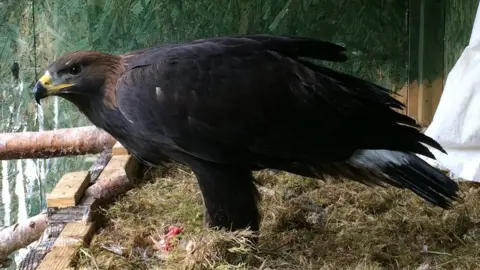The highs and lows of the South of Scotland Golden Eagle Project
 Getty Images
Getty ImagesThe disappearance of a golden eagle in the Borders is a blow to efforts to boost numbers in southern Scotland.
Over the past five years, a project has been ongoing from a base near Moffat to increase levels in the area.
Police are treating the latest incident - between Heriot and Stow - as suspicious and have vowed to protect the "magnificent birds".
Eagle numbers are at their highest level in centuries - but the scheme has not been without its setbacks.
How it all began

The first chicks from the South of Scotland Golden Eagle Project (SSGEP) were released in the area in August 2018 more than a decade after the idea was initially hatched.
They had been brought to a secret location in the Moffat Hills from the Highlands.
At the time, there were between two and four breeding pairs in the south of Scotland.
Cat Barlow, project manager, described it as a "very significant" moment.
"We are trying to boost the dwindling population and make sure that we are seeing a bird that should be here in the skies of the south of Scotland," she said.
An early setback
 SNH
SNHThe project was just a year old when one bird apparently attacked another, causing its death.
Scotland's natural heritage agency NatureScot said the incident was "distressing and extremely surprising" and was behaviour it had "not observed before".
A female bird released in 2018 appeared to have turned on a male bird introduced the following year.
The eagle, named Beaky, had returned to its release site and was witnessed being "aggressive and domineering" towards three birds.
However, NatureScot said it remained determined to see the project achieve its goals.
Doubling up
 Phil Wilkinson
Phil WilkinsonDespite the loss of one of the young golden eagles, more were brought from the Highlands and by August 2021 eight more chicks had been successfully moved south.
It took the total number relocated to 12 and nearly doubled the local population in the space of three years.
The project had suffered some delays due to Covid but it said it was "absolutely amazing" to see so many birds "soaring majestically" across south of Scotland skies.
NatureScot chief executive Francesca Osowska described the scheme as a "vital part" of efforts to reverse biodiversity loss and combat the climate emergency.
Record levels
 South of Scotland Golden Eagle Project
South of Scotland Golden Eagle ProjectEarlier this year, the number of golden eagles in southern Scotland had hit its highest recorded level in centuries with the population reaching nearly 50.
Although the project began by bringing chicks, it has started to introduce older birds making it the first scheme in the UK to move golden eagles aged between six months and three years from one part of the country to another.
Ms Barlow said the success of moving the older eagles would be monitored closely by similar projects.
Meanwhile, thousands of people had got involved in the SSGEP through a range of initiatives and a festival celebrating the golden eagle has also been staged in Moffat.
Turbine protection
 Getty Images
Getty ImagesPlans for a major wind farm near Moffat were scaled back in January this year amid concerns they could have an impact on the golden eagles.
Community Windpower initially wanted to build 75 turbines at Scoop Hill but cut that back to 60 following consultation.
The RSPB objected to the original proposals due to concerns about the collision risk and habitat loss for the birds.
The company said it hoped the changes being proposed could address those issues.
Mystery death and disappearance
 SSGEP
SSGEPWhen a bird was found dead on a south of Scotland estate in February this year it prompted a lengthy investigation into the cause with concerns it could have been poisoned or have been a victim of avian flu.
Both of those were ruled out and it was concluded the bird - named Sula - had been "very fit" prior to its death.
The SSGEP said it showed that golden eagles, like any species, could die suddenly for a variety of reasons - including natural causes.
However, it said the survival rate in southern Scotland remained high and it hoped that would continue in the years to come.
The death of one bird has now been followed by the disappearance of another.
The female eagle - Merrick - was last seen in the Borders on 12 October in an area between Heriot and Stow.
Police believe she has come to harm and are investigating the circumstances.
The golden eagle project - and all its partner organisations - have vowed to keep up their efforts to boost golden eagle numbers in the area despite the setback.
